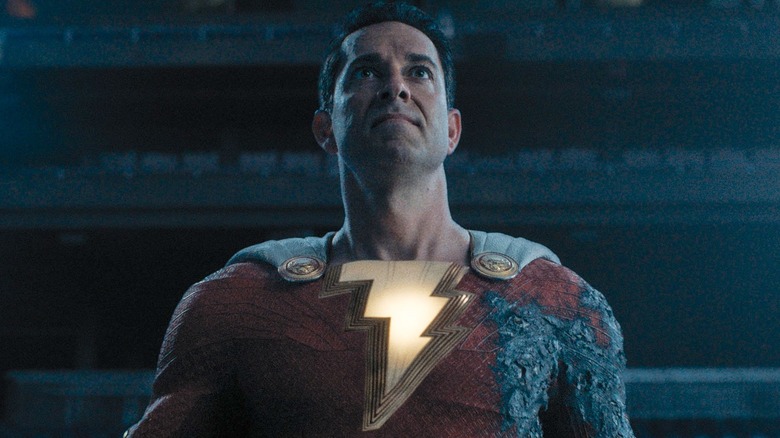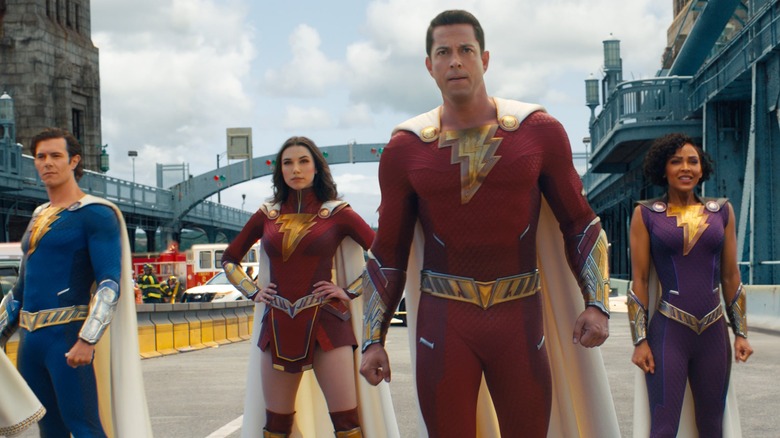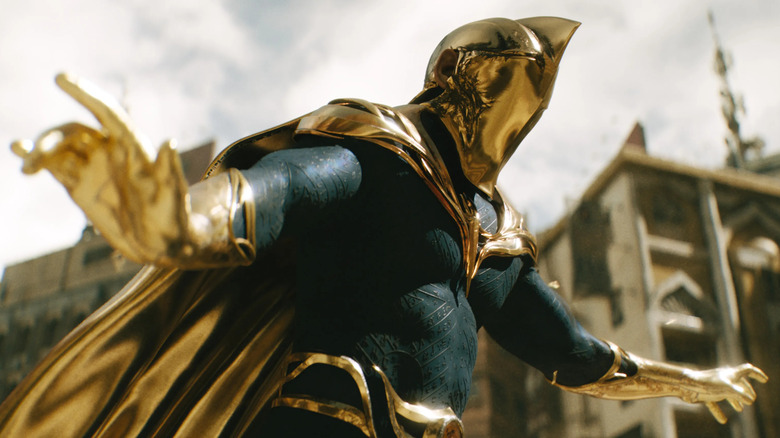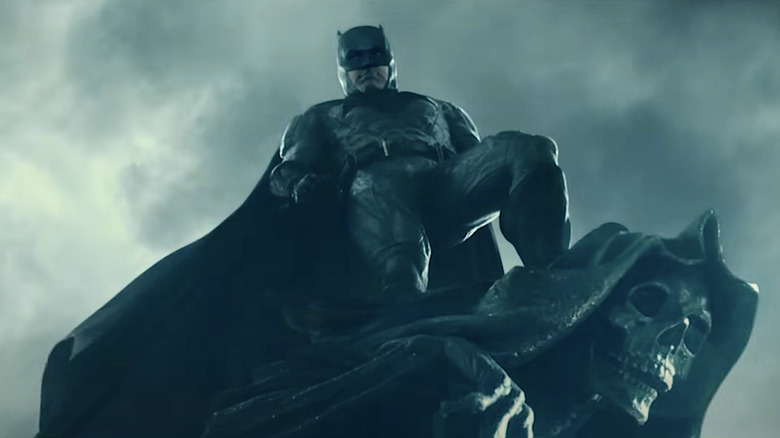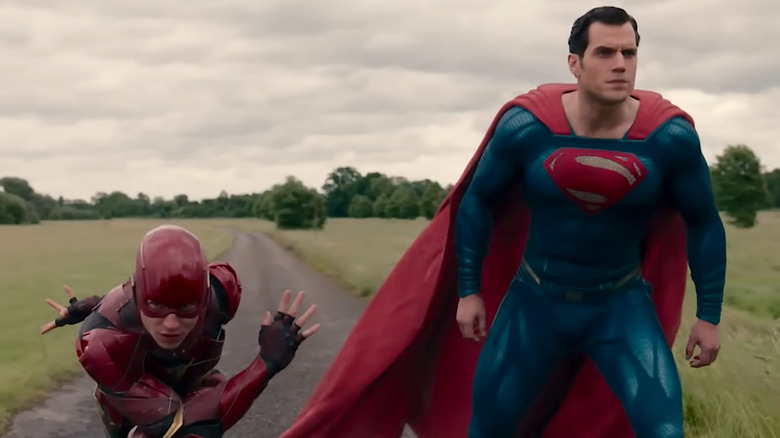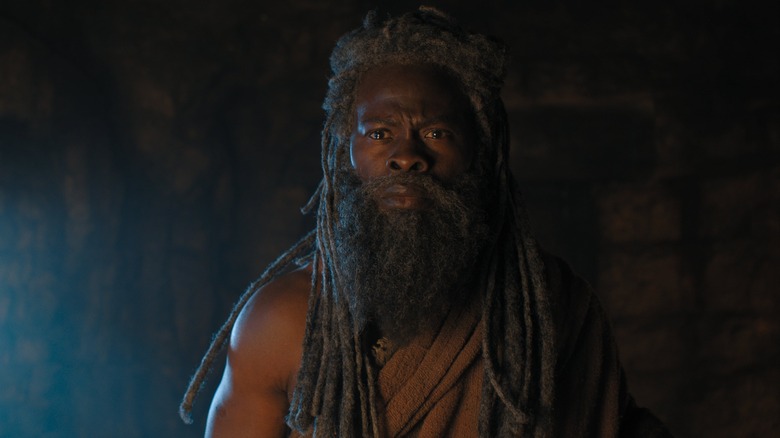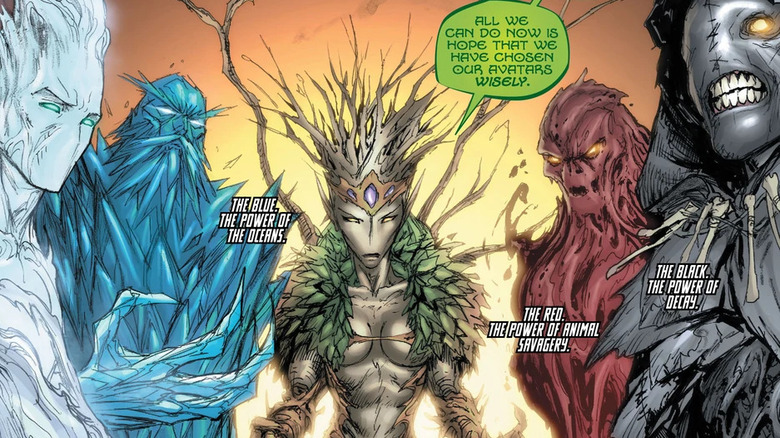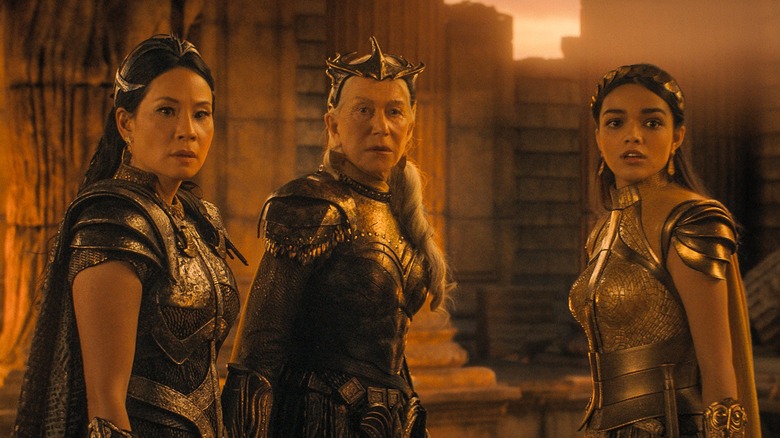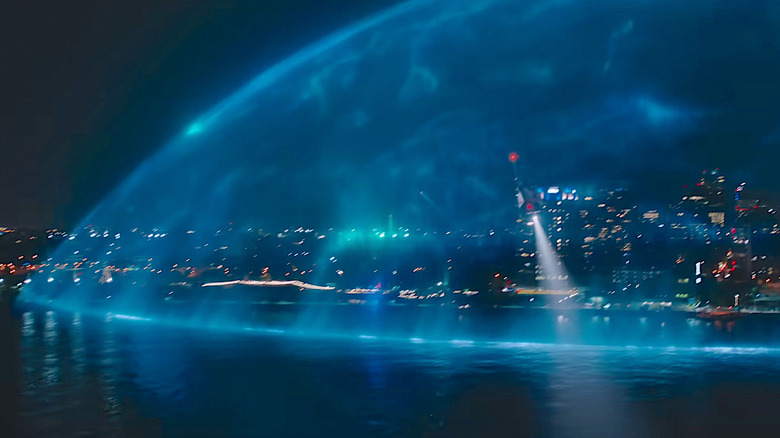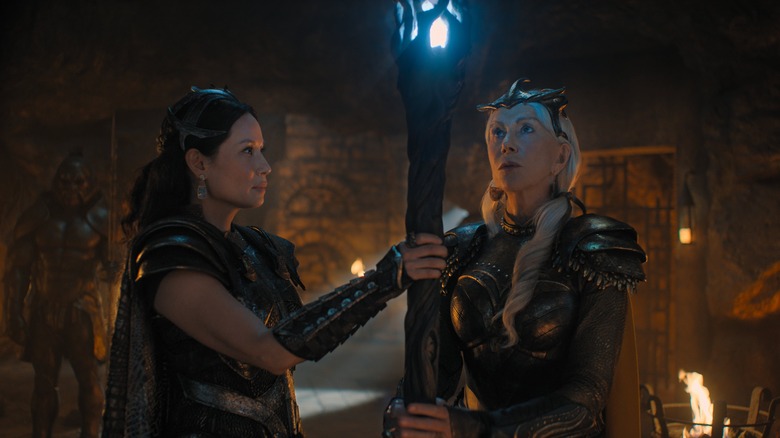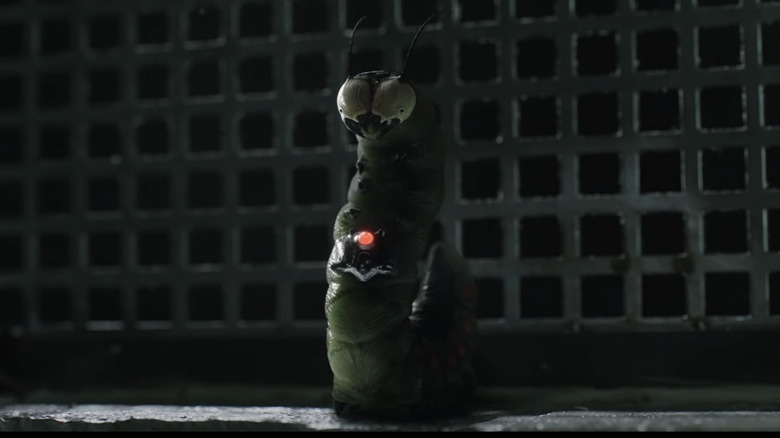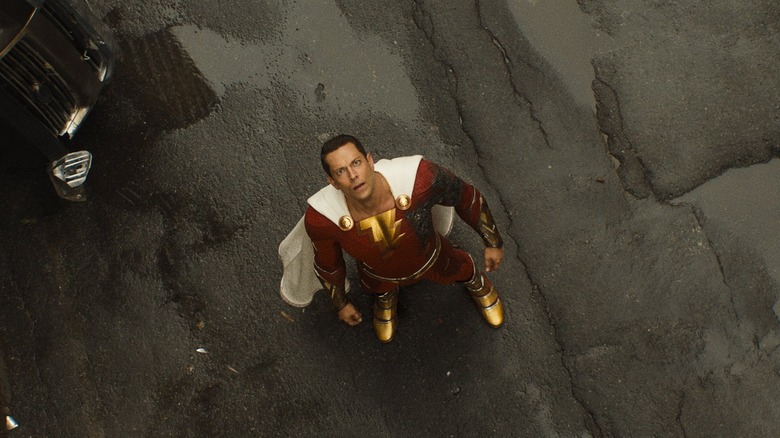Biggest Unanswered Questions In Shazam! Fury Of The Gods
A superhero sequel to a tee, "Shazam! Fury of the Gods" builds on everything that defined 2019's "Shazam!" by making everything more. There are more heroes, more villains, more action, more fantasy, and along with it, more convoluted lore and unanswered questions. It's not so much a fault of the movie as it is a guarantee of the genre — when wizards, aliens, caped crusaders, and Greek gods meet, a few questions are bound to pop up.
In particular, "Shazam! Fury of the Gods" seems to cause more chin-scratching for two reasons, which coincide with two of the franchise's main focuses: its love of Easter eggs and its (literally) labyrinthine lore. When Billy Batson (Asher Angel, an equally plausible comic book name) becomes Shazam (Zachary Levi), he taps into the power of six beings — drawn from a combined pool of Greek Gods, Titans, and warriors, as well as Roman Gods and biblical kings. Naturally, that places Shazam in front of a few thousand years of backstory, and when you add in all the typical superhero fare and adolescent obsessions with pop culture and reference humor, you get a seemingly simple story that is anything but. Like a ball of thread helping you through the labyrinth, we're here to ask the biggest unanswered questions in "Shazam! Fury of the Gods."
How does the staff choose to age heroes?
After watching "Shazam!," we were well within our rights to wonder how and why the Wizard's staff chose to age the people it empowered, but "Shazam! Fury of the Gods" adds another major wrinkle to issue, potentially making the question way more vexing.
An immediate question about the transformations is why, as there are dozens and dozens of adolescent superheroes in comics who don't require physical transformation to use those powers (like the Titans, whose powers all work whether they're the Teen variety or not). But at least the transformations in "Shazam!" were consistent — each child took on their own adult form when they powered up, and each kid became the same form every time. In "Shazam! Fury of the Gods," however, every kid takes on a new adult form except for Mary, who is played by Grace Caroline Currey in both "forms" and simply changed outfits between them.
The most obvious potential answer is that the magic transforms anyone under 18 into a post-18 form, but that itself raises more questions than it answers. Why 18 — was that the official age of adulthood to the ancient Council of Wizards? Does it age the kids into their 18-year-old selves? If so, Mary's lack of transformation makes sense, but that would mean that Batson, who's just a few weeks shy of 18, will turn into Levi in just a few weeks, and that's a pretty inexplicable amount of growth for that time period.
What happened when Shazam turned the magic off?
Early on in "Shazam! Fury of the Gods," the Wizard (Djimon Hounsou) exclaims his disbelief at seeing the Daughters of Atlas traveling between worlds and performing magic. During this exchange, he lets slip a few major plot points with massive implications, and then quickly moves on, evidently forgetting he ever cared. One of those points is the fact that his staff is the source of all magic, and that while it was broken, the goddesses should not have been able to access their magic — nor, possibly, anyone else on Earth or the realm of gods.
It's said in "Shazam! Fury of the Gods" that two years passed between the two movies, so apparently, the DC universe was without magic for two years. That doesn't seem to track with any number of other goings on in the greater DC universe, including huge chunks of "Black Adam," for example. Black Adam (Dwayne Johnson) himself relies on magic for his powers, as does his newfound ally Doctor Fate (Pierce Brosnan), so how did the events of that movie even take place?
Even if it really is just the gods that lose access to their magic, how and why is that? How did Kalypso (Lucy Liu) and Hespera (Hellen Mirren) travel between realms without the use of magic? Yes, they have the teleportation door between their labyrinth and the Rock of Eternity, but does that mean that they entered Earth and began their scheme in Shazam's own headquarters?
Which Wayne tagged the Rock of Eternity?
Since the events of "Shazam!" in which the Wizard evaporated into a pile of magic dust, the fabled Rock of Eternity has been passed to Shazam and his foster siblings, aka the Shazamily. As you'd expect from any adult-free hideaway populated by six kids for two years, it has become a sty. Early in "Shazam! Fury of the Gods," we get to see a lot of the Rock, and it no longer looks like the sacred magical nexus, but rather the Lost Boys' tree house from "Hook." A huge part of that aesthetic is all the defacement and graffiti on the lair's many statues, one example of which reads simply "Wayne." That name carries a lot of weight in the DC universe, so we have to ask: who spray-painted the Wayne name in the Rock of Eternity?
At the very end of "Shazam!" we were treated with a Superman cameo (from the neck down, at least) that proved Shazam knows the Man of Steel, at least passingly. Likewise, the ending of the sequel establishes that Shazam also knows Wonder Woman. It stands to reason, then, that the hero could know Batman as well, meaning Bruce could be the Wayne that tagged one of the Rock's demon statues with his name. But given that Bruce isn't one to commit petty crimes aside from his usual vigilantism, perhaps a better candidate would be his son and fourth Robin, Damian Wayne.
Did Shazam race the Flash?
DC comics have a plethora of super-speedsters, most of which can be placed in an approximate hierarchy of slowest to fastest, with the Flash at the very top. Unlike the comics, however, the DC cinematic universe isn't quite as fleshed out, and the pecking order is still being determined (and most likely re-determined again once James Gunn relaunches the whole thing). The first big speedster vs. speedster moment in the fledgling universe comes at the end of "Justice League," in which Superman and the Flash begin a very literal cross-country race. The two heroes will know who's truly the fastest, though it's unlikely anyone else would. This brings us to an important question posed by "Shazam! Fury of the Gods:" How does Shazam know who the fastest is?
While in his pediatrician's office, Shazam vents his existential ennui, a part of which stems from the Flash already being a red-suited, lightning-bolted, hero. As Shazam says, "I'm fast but he's faster." The new Flash movie is yet to take place, so it's unlikely that the world at large has any clue about Flash's connection to the speed force and the universe-altering heights of his speed. For Shazam, who possesses the actual speed of Mercury (Roman counterpart to Hermes), to be sure that the Flash is faster, he may very well have had to test it in the same way Superman did: an old-fashioned race.
The porous barrier between Earth and the gods
We've mentioned that Shazam's decision to snap the Wizard's staff in two at the end of "Shazam!" enabled the entire sequel to take place, as well as a few other unforeseen consequences. As the Wizard reveals, an ongoing spell cast through the staff maintained a barrier between Earth and the world of the gods. That is why the Wizard seems so shocked to see the Daughters of Atlas before finding out about the staff — how could they possibly have made it to Earth?! Oddly enough, there is an easy answer, and it's 100% the Wizard's fault. Moreover, it's almost unbelievable that the Wizard forgot about the answer, too.
In the Rock of Eternity, the Wizard kept a teleporting door that led straight to the labyrinth in the Daughters' home mountain. In what has to be one of the most glaring design flaws in history, the Wizard maintained an instant means of infiltration into his secret lair, and furthermore, made it especially easy to access for some of his sworn enemies. Superman's Fortress of Solitude doesn't have a hidden flight path to LexCorp tower. Batman's Batcave doesn't keep a subway line to whatever clown-themed den the Joker has constructed that week. Yet the wise and venerable Wizard left a backdoor open to Earth when sealing it up was almost certainly within his power.
Other gods, other pantheons
There are potentially far more unspoken consequences to Shazam destroying the Wizard's staff than what we see in "Shazam! Fury of the Gods," but unlike those that merely poke at potential gaps in logic, some are genuinely exciting prospects for the franchise. Specifically, the existence of far more gods and alien entities in the DC universe than just the Daughters of Atlas, all of which may have had the same opportunity to sneak themselves onto the newly-accessible Earth.
In a sense, this represents the same gift that "The Flash" movie will grant the new DCU: whenever walls are torn down and rules defied, the cinematic universe can organically shift its status quo to something potentially bigger and better. The Greek Gods have had their heyday in films like "Wonder Woman" and "Fury of the Gods." There are a lot more deserving of screen time, and with Earth's defenses apparently down for two years, they may have just gotten their chance. The most obvious of these potential inclusions is the Egyptian pantheon, known as the Ennead, who are every bit as colorful (if not more so) than the Greek pantheon, and already come with a major in-universe connection: just as Shazam draws on six Greek (and Roman and Abrahamic) figures for his powers, Black Adam draws on six Egyptian gods.
What is a god, anyway?
This is a question almost sure to provoke a reaction from diehard fans of DC comics (for better or worse), but what the heck is a god in the DC universe? The comics have their own, relatively definitive answers, categorizing beings as Old Gods, New Gods, demigods, and dozens of other immortal factions. The DCEU, however, hasn't had the time or need to categorize its super-beings so thoroughly, and it's led to some confusing plot points and lines of dialogue when it comes to its so-called (or completely unlabeled) gods.
In "Wonder Woman," Ares tells the Amazon that "Only a god can kill another god." At the end of "Fury of the Gods," Wonder Woman introduces herself as a demigod. Back to her first movie, she killed Ares, meaning one or both of their assertions about godhood are wrong. Likewise, the Wizard calls Shazam "a true god," which could just be metaphorical praise, but Shazam does kill the goddess Kalypso. That would (or at least should) make him a god and therefore mean that first movie baddie Sivana (Mark Strong) could never have succeeded in killing him — unless, of course, his magic made him a god, too. And if both of them are gods due to the Wizard's magic, then Black Adam must be, too. Added together, all of those ifs and hows form the nagging question: what is a god, anyway?
Why the dome? Why now?
There's one plot point in "Shazam! Fury of the Gods" that has drawn praise for its clever buttress of the narrative and its believability, and that's the magic dome that seals off the movie from the greater DC universe. Certainly, when you examine the movie on its own, the idea of the magic dome seems obvious. It prevents any pesky questions like "Where were the Justice League during all of this?" and ensures that our heroes face their challenges on their own, as demanded by the story. But the inclusion of the separating device now, after so, so, so many other superhero films, takes a neon highlighter to all the movies that came before and didn't spend one iota of effort addressing the same issue.
Despite being set on a remote island, "Suicide Squad" clearly featured a Justice League-level threat — in fact, Starro debuted in the same issue as the Justice League and was their first villain. Yet, the movie had no League. Sure, Black Adam's supposed rampage was answered by the Justice Society, but there's no way Superman would have seen that carnage and chosen to sit that one out. Instead, those movies and many like them all force viewers to ask where all the other heroes are, and their absence becomes exponentially more glaring now that one movie (especially one so late in the DCEU's life) finally addressed it.
Does the staff have a limit?
As "Shazam! Fury of the Gods" enters its emotional climax, the Wizard finally tells Shazam that he is the right champion to wield the powers of the gods. As the Wizard explains, his reasoning is largely because Shazam shares his powers with his siblings without a second thought, always believing the best in people and willing to give them the tools to prove him right. It's a sweet thought and a touching moment, but it absolutely begs the question — why doesn't Shazam grant the staff's godly powers to more people, then? Does the staff have a limit we don't know about?
Yes, this line of questioning seems to be a direct analogy of the classic Marvel question "Why doesn't Tony Stark simply make an Iron Man suit for all the Avengers, especially since he already makes dozens for himself?" But the Shazam version of the question runs deeper and is more vexing, because, unlike power suits, the magic doesn't seem to cost a thing. What's more, as we mentioned, the Wizard specifically tells Shazam he's a worthy champion because he gave so many others the same powers. Surely, then, he would be an even better champion if he gave out more? Does he not see the best in anyone besides his siblings? We're willing to bet non-powered but heroic figures like Batman would benefit tremendously from lightning fingers and nigh-invulnerability.
Peacemaker, ARGUS, and the Butterflies
It may just be a coincidence, but The DC cinematic universe has now featured three examples of mind-controlling invertebrates in its properties — two of which, a caterpillar and a butterfly, are potentially the same species. We can't recall another cinematic universe that managed such a coincidence before and frankly, there aren't that many movies with even one such example. With Mister Mind back in a "Shazam! Fury of the Gods" post-credits scene, we have to ask the obvious question: is Gunn planning some larger connection between the psychic butterflies in "Peacemaker" and the psychic caterpillar in the two Shazams? Perhaps even the psychic starfish in "Suicide Squad," as well?
Okay, perhaps the inclusion of Starro is a stretch, but then again perhaps not — there are far more confusing moments in superhero films, especially those in connected universes, and doubly so in those that blend genres as much as Shazam. Yet even if we ignore Starro, the connection between the butterflies and Mister Mind is too much to ignore. The endings to both Shazam films feature Mister Mind, who evidently has spent years working on some unknown, nefarious master plan, and likewise, "Peacemaker" centers around thwarting the butterflies and their plan to enslave humanity. If we're wrong, we're wrong, but if the new DCU heroes end up battling an entire zoo of mind-controlling creepy crawlies (not so much a stretch for the writer and director of "Slither") then you heard it here first.
Is there still room for Shazam in James Gunn's DC?
Despite the numerous unanswered questions that arise from "Shazam! Fury of the Gods" (or simply from our own exciting theorizing) within its universe, the single biggest question surrounding the movie lies within our own: can and will Shazam survive in Gunn's newly rebooted DCU?
If we're right about our Mister Mind and Butterflies connection, then it's possible Shazam will survive. On a far more likely note, the fact that agents of ARGUS showed up in a post-credits scene to recruit Shazam to the Justice Society makes the character's return plausible. The presence of the ARGUS agents, specifically Emilia Harcourt (Jennifer Holland) and John Economos (Steve Agee), is an even more propitious sign, as the two characters originate in Gunn's own "Suicide Squad" and play major roles in Gunn's other DC project, "Peacemaker." For Gunn to okay their inclusion in "Shazam! Fury of the Gods," especially well after the announcement that he'll be rebooting the universe, is an excellent sign for Shazam's inclusion and for fans of Levi's portrayal of the character.
Ultimately, however, the fate of Shazam, and specifically Levi in the role, will be up to the fans and the box office returns for "Fury of the Gods." Both Levi and Henry Gayden, co-writer of "Shazam! Fury of the Gods," revealed to Deadline that the character's fate rests in the court of popular demand, or as Levi put it, "It all comes down to what the people want."
